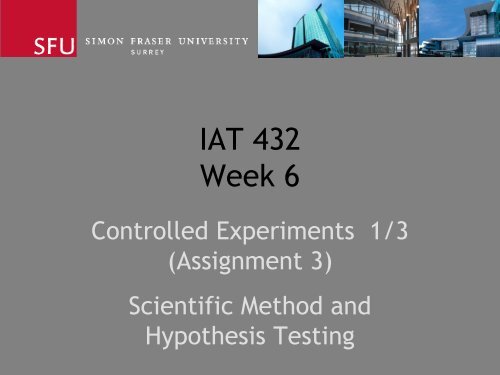Controlled Lab Experiments - Allen Bevans
Controlled Lab Experiments - Allen Bevans
Controlled Lab Experiments - Allen Bevans
Create successful ePaper yourself
Turn your PDF publications into a flip-book with our unique Google optimized e-Paper software.
IAT 432<br />
Week 6<br />
<strong>Controlled</strong> <strong>Experiments</strong> 1/3<br />
(Assignment 3)<br />
Scientific Method and<br />
Hypothesis Testing
• Examples?<br />
What is Science?<br />
2
• Examples?<br />
What is Science?<br />
• How is that different what Designers do?<br />
3
• Systematic inquiry<br />
What is Science?<br />
• Community standards (rigor)<br />
• Repeatable<br />
4
Descriptions vs Explanations<br />
• Description: Qualitative<br />
– Words<br />
– Summarized via top-down or bottom-up analysis, written<br />
summary.<br />
– “I observed these statements…”<br />
• Description: Quantitative<br />
– Numerical data sets<br />
– Summarized via stats, graphs, etc.<br />
– “I observed these measurements…”<br />
5
Descriptions vs Explanations<br />
• Explanation: Qualitative<br />
– Top-down or bottom-up analysis<br />
– Shaped by what we expect<br />
– “These statements suggest…”<br />
• Description: Quantitative<br />
– Statistical analysis<br />
– Shaped by what we expect<br />
– “These measurements suggest…”<br />
6
Descriptions vs Explanations<br />
• Explanation: Qualitative<br />
– Top-down or bottom-up analysis<br />
– Shaped by what we expect<br />
– “These statements suggest…”<br />
• Description: Quantitative<br />
– Statistical analysis<br />
– Shaped by what we expect<br />
• How do we know what to expect?<br />
– “These measurements suggest…”<br />
7
• Theory<br />
• Causes and effects<br />
Scientific Method<br />
– A causes B effect or A affects B.<br />
• Testable hypothesis<br />
• <strong>Controlled</strong> Experiment with subset of population<br />
• Evidence to support hypothesis?<br />
• Generalize to population<br />
8
Experimental Method<br />
• Scientific Method � Empirical Method<br />
• “Evidence”<br />
• Claims/hypotheses<br />
• Quantitative Data<br />
• Objective<br />
9
A � B<br />
Causes and Effects In Usability<br />
• A = cause = input or interface feature<br />
• B = effect = human performance, preference,<br />
experience<br />
• Common form:<br />
– A1 is better than A2 for causing B<br />
10
<strong>Controlled</strong> Experiment Approach<br />
A controlled experiment for usability evaluations is good<br />
for certain kinds of questions …<br />
• Is one design better in terms of usability than another?<br />
• Does a change in interface feature change usability?<br />
– i.e. performance (effectiveness/efficiency) or preference<br />
(satisfaction)<br />
11
Mouse Size Example<br />
• Theory: Mouse size affects children’s performance on<br />
selection tasks<br />
• Hypothesis: Children can select targets faster with a<br />
small mouse compared to a regular mouse.<br />
• Comparative controlled experiment<br />
– Cause: Mouse size -- e.g., MS Optical mouse 15 cm L x 10<br />
cm W x 7 cm H vs 10 cm L x 7 cm W x 4 cm H<br />
– Effect: task speed from beginning to select<br />
– Population: children age 4-6<br />
12
• Empirical<br />
Term<br />
= Relying on or derived from observation<br />
For example, a user-based usability study is an<br />
empirical study.<br />
13
• Hypothesis (singular)<br />
• Statement<br />
• Causes and effects<br />
Hypotheses<br />
• Interface design A causes B<br />
• Comparing two designs<br />
– A1 is better than A2 for B<br />
14
• Example<br />
True or Not? The Logic of Proofs<br />
– Statement: All swans are white.<br />
– Observe 10,000,000 swans.<br />
– All the observed swans are white.<br />
– Proof?<br />
15
True or Not? The Logic of Proofs<br />
• Can NEVER prove a hypothesis …<br />
• Can NEVER prove a statement with observations.<br />
• Can only find support for or disprove.<br />
• Example<br />
– Statement: All swans are white.<br />
– Observe 10,000,000 swans.<br />
– All the observed swans are white.<br />
– Proof? No. Support: Yes.<br />
16
Logic of Proofs cont’<br />
Prove by disproving opposite statement.<br />
How to disprove … If all swans are white, then no swans are<br />
black.<br />
Opposite statement: No swans are black (blue, pink,<br />
orange)<br />
Find 1 black swan!<br />
No swans are black is disproven.<br />
17
Logic of Proofs cont’<br />
In Scientific method – the approach is to disprove a “null”<br />
hypothesis.<br />
All we can say, then, is “Evidence supports…”<br />
18
Apply logic of proofs to hypotheses<br />
• Opposite is “no effect” … “no better”<br />
• Called “null” hypothesis …<br />
• E.g. Smelliness and dating<br />
• General = Smell effects number of dates.<br />
• Null = Smell does not effect number of dates.<br />
19
Apply logic of proofs to hypotheses<br />
• Opposite is “no effect” … “no better”<br />
• Called “null” hypothesis …<br />
• E.g. Smelliness and dating<br />
• General = Smell effects number of dates.<br />
• Null = Smell does not effect number of dates.<br />
• Directional = Smell gets more dates.<br />
– Better smell gets more dates?<br />
20
Operationalizing the Hypothesis<br />
• Hypothesis must be testable<br />
• Operationalize �<br />
1. Isolate & specify cause (e.g. interface feature)<br />
2. Measure effect (performance, preference,<br />
experience) on some kind of activity/task<br />
3. Specify population<br />
21
Mouse Size Example<br />
• Theory: Mouse size affects children’s performance on<br />
selection tasks<br />
• Hypothesis: Children can select targets faster with<br />
small mouse than regular mouse.<br />
• Comparative two designs in a controlled experiment<br />
– Cause: Mouse size -- e.g., MS Optical mouse 15 cm L x 10<br />
cm W x 7 cm H vs 10 cm L x 7 cm W x 4 cm H<br />
– Effect: task speed from beginning to select<br />
– Population: children age 4-6<br />
22
Mouse Size example cont’<br />
• Measure task time for small and regular groups<br />
• Quantitative Data<br />
– Two data sets, one for small mouse and one for regular<br />
mouse group<br />
– For each -- average time value across 10 tasks for 20<br />
children.<br />
• On average, is a smaller mouse faster?<br />
• If it is, did we prove hypothesis? NO…<br />
23
Mouse Size Example<br />
• Say we found on average, that children were faster<br />
with smaller mouse.<br />
• Null Hypothesis: Mouse size does not affect children’s<br />
speed on target selection tasks.<br />
• But we found, on average for 20 children that they<br />
were faster with smaller mouse …<br />
• So Null can’t be true … disprove Null.<br />
• Original hypothesis is “supported” (not proved)<br />
24
More terms … Variables<br />
A variable is something that changes and can have<br />
different values that can be specified or measured<br />
Examples<br />
Font size = 8, 10, 12 (varies & can be 8 or 10 or 12)<br />
Colour = red, green, blue (varies & can be one of … )<br />
Time = n seconds (n varies & can be 0 – 600 seconds)<br />
Error rate = x% (x varies & can be 0 – 100%)<br />
Subject type = novice or expert, male or female<br />
25
Kinds of Variables<br />
• Cause � Independent Variable (IV)<br />
– The input or interface feature you have different designs<br />
for (e.g., mouse size = small or regular)<br />
– Characteristics of users (novice/expert)<br />
• Effect � Dependent Variable (DV)<br />
– the human behaviors or experiences that you measure for<br />
each level of the IV.<br />
– E.g., task time = 0 – 600 seconds<br />
26
Independent Variable<br />
• The thing experimenter change or manipulate<br />
independent of users’ behavior to see how it affects<br />
users’ behavior<br />
– Often some small aspect of an interface feature<br />
– Can also arise from grouping users (expert/novice)<br />
• Examples<br />
– Font size 8, 10 or 12<br />
– Keyboard layout style phonepad or alphabetic<br />
– Expert vs novice users<br />
27
Dependent Variable<br />
• A variable that depends on users’ behaviors<br />
• The thing you measure<br />
• So, a dependent variable is some aspect of behavior<br />
that changes/varies and can be measured like “task<br />
time” or “rating”<br />
28
Hypothesis<br />
• Related independent and dependent variables<br />
• A change in indep var causes an effect on dep variable<br />
• Indep var = mouse size; dep var = task time<br />
• Hyp: A smaller mouse size improves task time for<br />
children age 4-6 on a target selection task.<br />
• Null: Mouse size does not affect task time …<br />
29
• Hypothesis<br />
Basic Form of CE for Usability Study<br />
• Independent variable = interface aspect(s)<br />
• Dependent variable = human performance/preference<br />
• Sample Population<br />
• Select levels of IV that are varied between groups<br />
• Measure DV(s) for each group<br />
30
About reading comprehension…<br />
31
About reading comprehension…<br />
32
About reading comprehension…<br />
33
About reading comprehension…<br />
34
This Week’s Studio<br />
• Work through Assignment 3<br />
• Install and run software<br />
• Data collection<br />
• Meet new team<br />
35
Next Lectures<br />
• Week 7: More on controlled experiments<br />
– Validity and Reliability<br />
• Week 7: Review of methods to date<br />
• Week 8: Analysis/Statistics … how do you know from<br />
the data sets that the DVs for groups are different?<br />
36
Read<br />
• Martin, Doing <strong>Experiments</strong> in Psychology<br />
• Chapters 1,2,7,8<br />
• Glossary<br />
• Dix Chapter 9 Handout 9.4.2<br />
37




